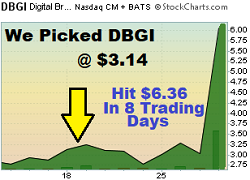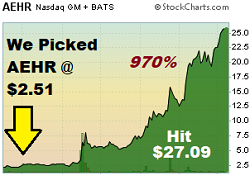|
Average Peak Gain For All Picks
Since 2004:
102.45% |
Reading
Market-Maker Signals
See the signs and messages they send each other
Many traders believe that market
makers will
"signal" moves in advance buy using
small amounts of buys or sells as
"signals". The "signals" are from one market maker to another.
-
100
I need shares.
-
200
I need shares badly, but do not
take the stock down.
-
300
Take (or I am taking) the price down so I can load
shares
-
400
Keep trading it sideways.
-
500
Gap the stock.
This is a theory put forth by a lot
of penny stock and non-penny stock traders. This is not
a guaranteed trading method but can
lend some insight to
market maker communications. It can pay to watch
a few market makers of your favorite stock
over several days or weeks to see
if they follow these or other
similar signals. That way, you can
divine what they are going to do
and jump in ahead of any move that
may come.
Personally, I have worked on the Nasdaq Market Maker desk of a major firm
and while the folks I worked with did not use any signs like the ones above,
they did know what certain other MMs were about to do by watching them move their
bids and asks. One example - When I first started and was sitting with one of the MMs,
he said "See that?
He dropped his ask and shows 1000 shares.
He's a buyer."
Say what? --
It wasn't even a minute later that the bids dropped lower after his 1000 share ask. As soon as the bids all dropped away, the asks from other MMs and
internet brokers all fell below his. He then bought thousands of shares about $0.25 lower
than where the bid was before his fake ask - on a $7 stock. These things happened
ALL of the time.
|
A Decuple - 900% |
 |
CEI
Profiled @ $0.4825
On August 10, 2021
Hit $4.85 For A
900% Gain In
A Few Weeks
See Our
Actual Report |
Why signals? Why not just
message or email?
One simple reason...
calling/emailing one or more of the
other market makers and telling them to
"take
the price
down" or
"I am
going to gap the
stock" would
be 100% ILLEGAL. Collusion at it's
finest. If caught, handcuffs could
replace their Rolex for a trip
downtown.
We've worked on
OTC/Agency (Nasdaq and OTC-BB) desks and
worked with many actual market makers. We can
attest that many market makers will use certain
signals. Some will
use fake
bids/offers to trick individual
investors and day traders. They are still
responsible for those bids/offers and would have
to buy or sell there if their bid or offer
is hit, but they post those to make others think
they have an order and do not really want to buy or sell
there.
When 100 Actually Means 25,000
When watching larger stocks, market makers from large firms will often bid for 100 shares when they actually want several thousand shares.
Market makers are in the game to make money as well as execute orders for their firm's clients.
If you do see a huge bid or ask - thousands of shares where it's not usual it's often a fake. That is, they really don't want to execute that trade but are actually trying to scare others and to move the stock the opposite way that their bid or ask would indicate. If the stock happens to trade closer and closer to that larger bid or ask, it will disappear. Smaller stocks and penny stocks are rife with that type of dishonest manipulation on OTC markets.
Market makers will almost never show their hand to let others know what order they are working. For instance, let's say a market maker for at a major firm receives an order to purchase 25,000 shares of a stock at a $5.00 limit for an institutional client. He will never bid for the full 25,000. He will place a 100 or 200 share bid at $5.00 or lower. Why? If the market maker places all 25,000 shares at the bid at $5.00, another market maker with shares to sell could "hit" that bid and sell him everything at $5.00. The trade is over; the bidding market maker has just bought all 25,000 at $5.00. However, using smaller bids and some patience will usually mean he can get shares a bit cheaper. With a 25,000 order, a difference of just a few cents can result in thousands of dollars.
The market maker with the bid will put up only 100-200 to see if any fish bite. If they do, he'll remember who sold him those and move his bid down to $4.95, $4.90, etc. and see if he can get more there. If he does, great, he'll keep working the price down as far as he can go to get the shares as cheaply as possible.
Perhaps he now has 25,000 shares with an average price of $4.80. Now that the market maker has 25,000 shares, he can then sell them to his customer at $4.90. At $4.90, the customer is happy because he would have paid up to $5.00 and the market maker is happy because he sold the shares to the client $0.10 higher than it cost him and he made a tidy profit of $2,500.
Market makers will almost never post a bid or ask for more han just a few hundred shares no matter how large their true need is. So if you do see a market maker from a large firm posting a bid for 500 shares, there's usually thousands of shares behind that. Unless he's sending signals and not selling just stock.
Subscribe
Today
|








